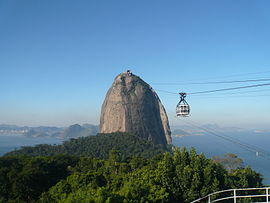Sugarloaf Cable Car
| Sugarloaf Cable Car Bondinho do Pão de Açúcar |
|
|---|---|

Sugarloaf Cable Car
|
|
| Overview | |
| Location | Rio de Janeiro |
| Country | Brazil |
| Coordinates | 22°57′20″S 43°10′1″W / 22.95556°S 43.16694°W |
| Open | 27 October 1912 |
The Sugarloaf Cable Car; Portuguese: Bondinho do Pão de Açúcar) is a cableway in Rio de Janeiro, Brazil. Moving between Praia Vermelha and the Sugarloaf Mountain, it stops at Morro da Urca (at 722 feet (220 m)) on its way up and down, and reaches the summit of the 1,299-foot (396 m) mountain.
The cableway was envisioned by the engineer Augusto Ferreira Ramos in 1908 who sought support from well-known figures of Rio's high society to promote its construction. Opened in 1912, it was only the third cableway to be built in the world. In 1972 the cars were updated, growing from a capacity of 22 to 75, and in 1979 it featured in an action scene for the James Bond film Moonraker. Today it is used by approximately 2,500 visitors every day. The cable cars run every 30 minutes, between 8 am and 10 pm.
The development of technical and engineering achievement of the National Exhibition in Commemoration of the First Centenary of the Opening of the Ports of Brazil to the International Trade in 1908 motivated engineer Augusto Ramos to imagine a cable car system in Rio de Janeiro. Ramos had to resort to well-known personages of Rio's high society. These included Eduardo Guinles and Raymundo Ottoni de Castro Maya, who were powerful figures with a range of developmental interests in the city, to promote the idea of an electric cable system. When the cable car was built, there were only two others in the world: the chairlift at Monte Ulia, in Spain, with a length of 280 metres (920 ft), built in 1907, and the lift at Wetterhorn, in Switzerland, with a length of 560 metres (1,840 ft), built in 1908.
The Sugarloaf Cable Car was opened on 27 October 1912. Its Portuguese-language name comes from the similarities between the cablecars, and the former trams in town. Envisioned by Augusto Ramos, it is managed by Companhia Caminho Aéreo Pão de Açúcar, a company created by Ramos.
The first cable cars were coated wood and were used for 60 years. Originally, the cable car stopped at Urca. In 1951, an accident occurred in which one of the two cables snapped, leaving 22 people dangling on one cable. One mechanic aboard, Augusto Goncales, climbed out and slithered down to Urca station and helped to build an emergency car to go back up and rescue the other passengers, 12 women and girls, 6 men and 3 children, in an event which took about 10 hours.President Vargas praised Goncales as the "Hero of the Day". In October 1972, a second cable was added, as well as new cabins, which expanded its capacity from 22 to 75; eventually, it was reduced to 65 to increase comfort. Prominent users of the service have included John Fitzgerald Kennedy, Lech Walesa, Gina Lollobrigida, Pope John Paul II, and Brooke Shields.
...
Wikipedia

